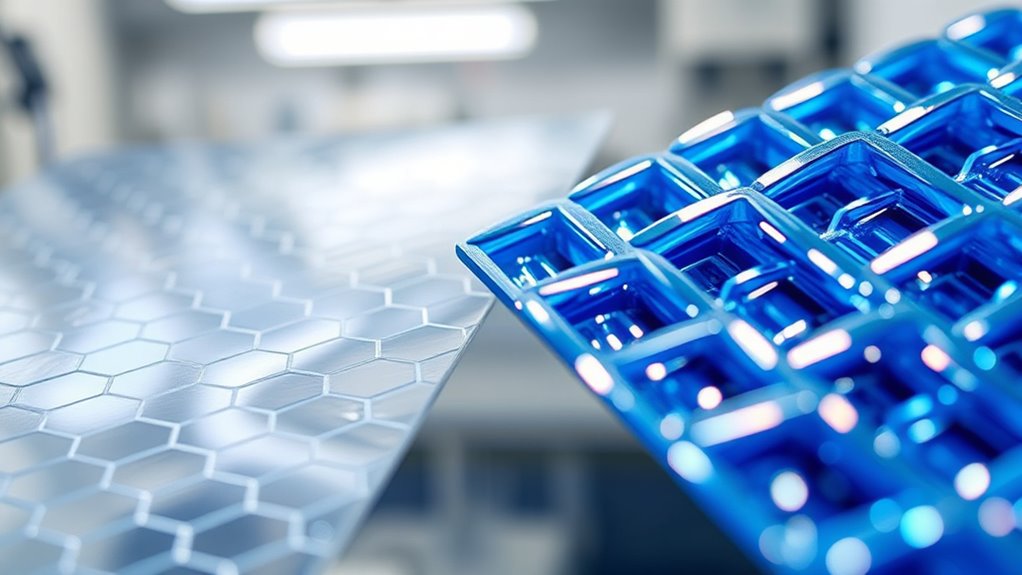If you’re wondering which 2D material will dominate the future, it depends on your needs. Graphene offers exceptional conductivity and flexibility, ideal for electronics, but it’s vulnerable to environmental degradation. MXenes provide enhanced stability and durability, making them suitable for harsh conditions and energy storage. Both materials have unique strengths, and advances in hybrid designs may shape the next wave of innovations. To see how these materials compare and future prospects, keep exploring this fascinating topic.
Key Takeaways
- MXenes offer superior environmental stability and durability, making them more suitable for long-term, real-world applications.
- Graphene excels in electronic conductivity and flexibility, ideal for high-performance electronic devices.
- Hybrid materials combining graphene and MXenes could leverage both conductivity and stability advantages.
- MXenes are better suited for harsh conditions, sensors, and energy storage due to their robustness.
- Ongoing research aims to enhance both materials’ properties, shaping their future dominance in advanced technologies.

Graphene and MXenes are two of the most promising 2D materials in modern science, each offering unique properties that make them ideal for various applications. When you look at their potential, their electronic conductivity and environmental stability stand out as key factors influencing their future roles.
Graphene boasts exceptional electronic conductivity, making it a top choice for electronic and energy storage devices. Its electrons move effortlessly across its honeycomb lattice, enabling fast signal transmission and efficient charge transfer. This high conductivity, combined with its lightweight and flexible nature, opens doors for advanced transparent conductors, flexible electronics, and high-performance batteries.
Graphene’s exceptional conductivity enables rapid charge transfer and flexible, high-performance electronic applications.
However, graphene’s environmental stability can be a concern; it’s susceptible to oxidation and environmental degradation, especially when exposed to moisture or chemicals, which can limit its long-term durability in certain applications. Recent research into protective coatings and functionalization methods aims to improve environmental stability.
In contrast, MXenes are a newer class of 2D materials that shine in stability and tunability. Their composition—transition metal carbides, nitrides, or carbonitrides—confers excellent environmental stability, allowing them to withstand harsh conditions better than graphene.
You’ll find MXenes particularly suited for sensors, electromagnetic interference shielding, and energy storage, thanks to their unique surface chemistry and layered structure. While their electronic conductivity can vary depending on their specific composition and surface termination, many MXenes exhibit conductivity levels comparable to, or even surpassing, graphene, especially when optimized.
This blend of good conductivity and environmental robustness means they can function reliably in real-world environments, where factors like moisture, temperature fluctuations, and chemical exposure are inevitable. Their stability ensures that devices built with MXenes won’t degrade quickly, extending their lifespan and maintaining performance over time.
Choosing between graphene and MXenes depends heavily on your application’s demands. If you need ultra-high electronic conductivity and are willing to implement protective measures against environmental factors, graphene might be your best bet.
On the other hand, if durability and environmental stability are priorities, especially in challenging settings, MXenes could provide a more reliable solution. Both materials continue to evolve, with researchers working to enhance their properties further.
Recent advancements in surface chemistry are further expanding the potential applications of MXenes, making them even more adaptable for future technologies. You may find future innovations that combine their strengths, leading to hybrid materials that leverage graphene’s conductivity and MXenes’ stability. Ultimately, understanding these key differences in electronic conductivity and environmental stability helps you make informed decisions about which 2D material to pursue for your specific needs, shaping the future landscape of advanced technologies.
Frequently Asked Questions
How Scalable Are Production Methods for Graphene and MXENES?
You should know that both graphene and MXenes face significant synthesis challenges and scalability hurdles. Producing high-quality graphene at large scales often involves complex and costly methods like chemical vapor deposition.
Meanwhile, MXenes require precise etching processes that are still being optimized. These hurdles limit mass production, but ongoing research aims to develop more efficient, scalable techniques.
Making both materials increasingly viable for future applications.
What Are the Environmental Impacts of Manufacturing These Materials?
You should consider the environmental impacts of manufacturing these materials. Both involve environmental toxicity risks, especially if toxic chemicals are used in production. Recycling challenges also persist, making disposal difficult and potentially harmful to ecosystems.
While graphene’s production is relatively cleaner, MXenes often require harsh chemicals, increasing environmental concerns. Being aware of these impacts helps you understand the sustainability challenges associated with mass-producing these advanced materials.
Can Both Materials Be Integrated Into Existing Electronic Devices?
Did you know that over 90% of electronic devices could benefit from 2D materials? You can integrate both graphene and MXenes into existing electronics, but device integration faces compatibility challenges like differing electrical properties and fabrication processes.
These challenges require innovative engineering solutions, but ongoing research aims to streamline integration, making it feasible to use both materials in future devices for enhanced performance and functionality.
How Do Cost Considerations Compare for Large-Scale Applications?
When comparing cost considerations for large-scale applications, you find that MXenes often offer better cost efficiency and market affordability than graphene.
MXenes are typically cheaper to produce and process, making them more suitable for widespread use.
While graphene’s superior properties come with higher production costs, MXenes’ lower costs could make them the more practical choice for commercial, large-scale deployment, giving you a real advantage in market competitiveness.
What Are the Long-Term Stability and Durability of Each Material?
You wonder about the long-term stability and durability of these materials. MXenes tend to have lower oxidation resistance, which can limit their durability over time, especially in harsh environments.
Graphene, on the other hand, offers excellent mechanical robustness and high oxidation resistance, making it more stable in long-term applications.
Understanding these factors helps you choose the right material for your specific needs, ensuring performance and longevity.
Conclusion
Imagine you’re choosing the next game-changer in 2D materials. If graphene’s incredible conductivity and strength make it ideal for flexible electronics, MXenes’ tunable properties could revolutionize energy storage. For instance, a hypothetical battery using MXenes might charge faster and last longer than traditional ones. Ultimately, both materials hold immense promise. Your decision depends on whether you prioritize strength and conductivity or tunability and application-specific features. The future of 2D materials is likely a blend of both.









